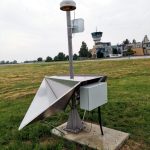Improved Height Determination with GNSS CORS and InSAR Technologies
Researchers in Hungary have developed a new method for geodetic height determination, exploiting the synergies of multi-constellation GNSS and interferometric synthetic aperture radar (InSAR). The solution, proposed by the Lechner Knowledge Center in Budapest, comprises a modernized reference network of integrated, continuously operating reference stations (CORS) with InSAR corner reflectors.
By Peter Gutierrez













